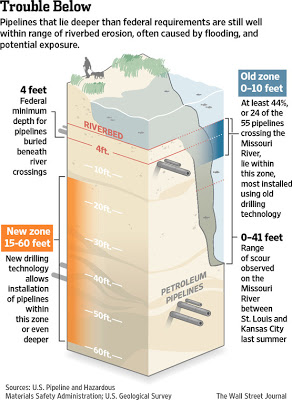

| Visitors Now: | |
| Total Visits: | |
| Total Stories: |

| Story Views | |
| Now: | |
| Last Hour: | |
| Last 24 Hours: | |
| Total: | |
Fuel Pipelines Vulnerable To Floodwaters
Federal investigators plan to announce soon that flood-caused erosion along the riverbed—known as scouring—exposed an Exxon Mobil Corp. pipeline on the Yellowstone River in Montana in 2011, causing it to break and spill 1,000 barrels of crude. A month later, an Enterprise Products Partners pipeline burst after it was exposed by scouring in a Missouri River floodplain in Iowa, spilling 818 barrels of a gasoline additive.
The greater weight and speed of floodwater can scrape dozens of feet of soil and gravel off a river’s bed, potentially exposing pipelines and leading to their rupture. Heavy snow and rain last year caused record flooding on the Missouri River basin, which includes the Yellowstone.
In January, Congress ordered a review of pipeline incidents at river crossings to determine if the pipelines’ depths were a factor. The study is expected to help lawmakers determine whether regulations should be strengthened.
The U.S. Geological Survey found severe scour last year at 27 sites surveyed along the Missouri River from Kansas City to St. Louis, with the riverbed deepened in places by nine to 41 feet. Other unpublished USGS research found more severe scouring upstream.
The federal agency for pipeline safety, the Pipeline and Hazardous Materials Safety Administration (PHMSA), learned of the pipelines’ depths through an optional survey of operators. When operators didn’t report the depths of 12 pipelines in the survey, PHMSA said it didn’t pursue the matter because it isn’t required to track pipeline depths. Under current rules, PHMSA leaves much of the oversight of pipelines to operators, who are required to inspect river crossings every five years.
“It is the operator’s responsibility to weigh and assess the risks associated with its pipeline,” PHMSA Administrator Cynthia Quarterman testified at a congressional hearing last year on the Exxon spill in Montana. “Especially in [flood conditions]. That is why we kept saying to them, ‘You need to check this pipeline out and watch it.’”
Reinstalling shallow pipelines at river crossings across the nation would cost billions of dollars, “and that would be a very high cost to consumers. Scour is typically temporary, with the holes refilled by sediment over time. (WSJ, 12/3/2012)
2012-12-05 02:02:18
Source: http://cenvironment.blogspot.com/2012/12/fuel-pipelines-vulnerable-to-floodwaters.html
Source:



